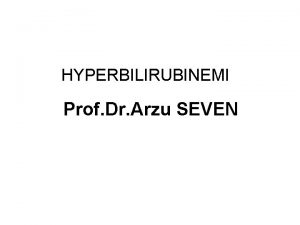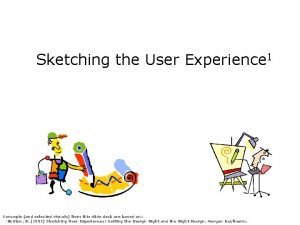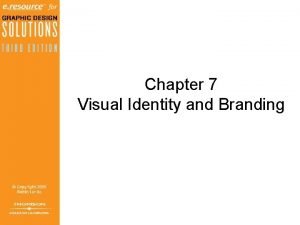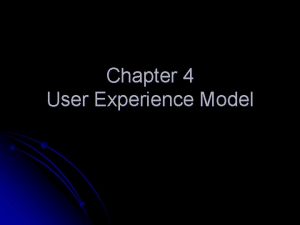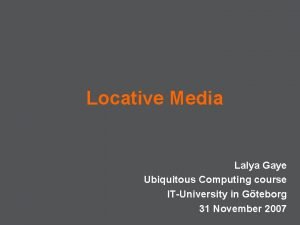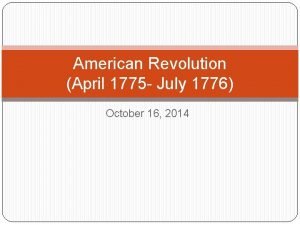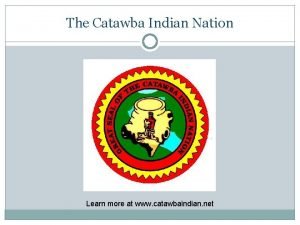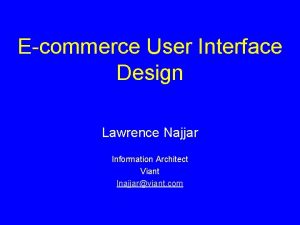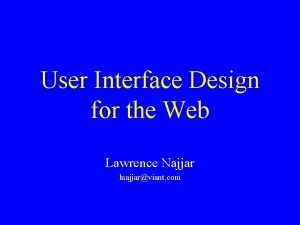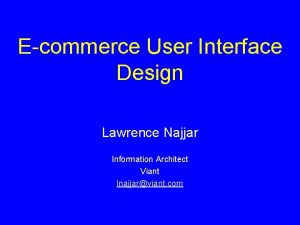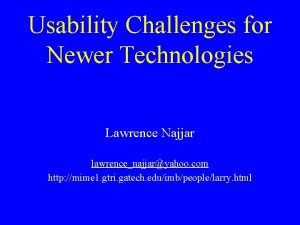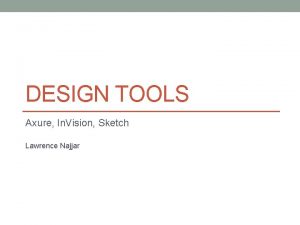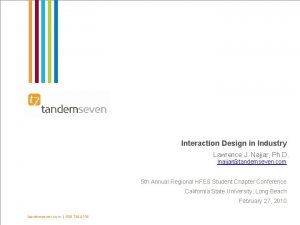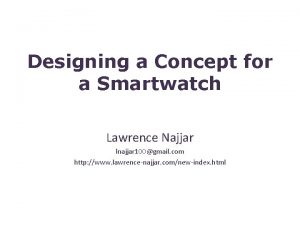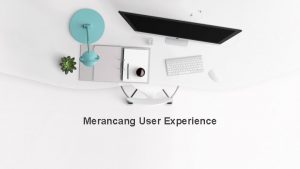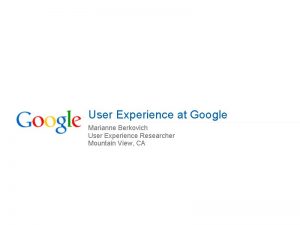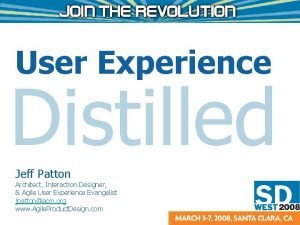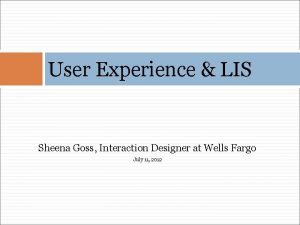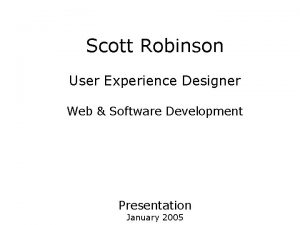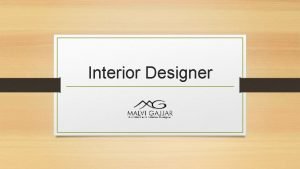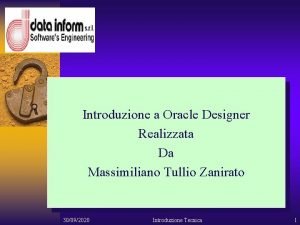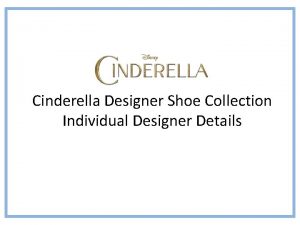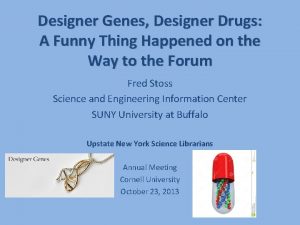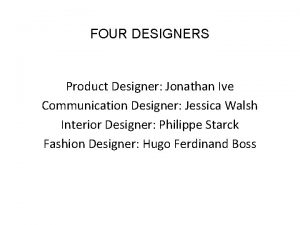User Experience Lawrence Najjar UX Designer July 16





































- Slides: 37

User Experience Lawrence Najjar – UX Designer July 16, 2019

Outline • • Terms Why is usability important? Usability benefits quiz Proposed Harris Affinity design system 2

Terms 3

What is a ”user interface”? 4

What is a ”user interface”? • The way users interact with a software • application Includes screens, buttons, hyperlinks, entry fields, graphics, keyboard, mouse 5

What does “user experience” mean? 6

What does “user experience” mean? • The elements that affect how users perceive • a product Includes packaging, installation, graphics, ease of use, response time, installation, support 7

What does “usability” mean? 8

What does “usability” mean? • Ease of use of the product • Includes familiarity, simplicity, consistency, and intuitiveness 9

How make applications easy to use? 10

How make applications easy to use? • Before coding, identify user needs, • • • preferences, & challenges Create design concepts Get feedback from teammates & representative users Improve design concepts Begin coding Get user feedback from representative users Improve coded design 11

Why make applications easy to use? 12

Why make applications easy to use? Usability increases: • • Ease of use User productivity 5, 7 User satisfaction 2, 5, 16 User trust 5 Company reputation 10, 11 Competitive advantage 2, 7, 14 Revenue 2, 5, 7, 12, 14 Usability decreases: • • • Learning time 2, 5 Training 12, 16 Staff turnover 2, 7 User errors 2, 10 Documentation costs Support costs 2, 5, 12, 16 Development time 4, 5, 16 Development costs 1, 2, 3, 4, 5, 6, 8, 9, 10, 13, 14 Maintenance 13

Usability Benefits Quiz 14

1. What percentage of an application’s code is for the user interface? a) b) c) d) 5% 10% 25% 50% 15

1. What percentage of an application’s code is for the user interface? a) 5% b) 10% c) 25% d)50% • Inveradi, P. (2005). Software engineering education in the modern age. Software Education and Training Sessions at the International Conference, on Software Engineering, ICSE 2005, St. Louis, MO, USA, May 15 -21, 2005, Revised Lectures • Myers, B. A. and Rosson, M. B. (1992). Survey on user interface programming. In CHI ‘ 92 Proceedings of the SIGCHI Conference on Human Factors in Computing Systems, 195 -202. Available: www-2. cs. cmu. edu/afs/cs. cmu. edu/project/garnet/doc/papers/uisurvey. CHI 92. ps 16

2. What percentage of development time is for the user interface? a) b) c) d) 5% 10% 25% 50% 17

2. What percentage of development time is for the user interface? a) 5% b) 10% c) 25% d)50% Myers, B. A. (1995). User Interface Software Tools, ACM Transactions on Computer-Human Interaction, 2(1), pp. 64 -103. 18

3. What is the rank of “user involvement” as a predictor of successful projects? a) b) c) d) 1 st 3 rd 5 th 7 th 19

3. What is the rank of “user involvement” as a predictor of successful projects? a)1 st b) 3 rd c) 5 th d) 7 th The Standish Group (1995). The CHAOS report [Online]. Retrieved from: http: //www. csus. edu/indiv/v/velianitis/161/chaosreport. pdf 20

4. What percentage of software defects is due to usability errors? a) b) c) d) 5% 15% 30% 60% 21

4. What percentage of software defects is due to usability errors? a) 5% b) 15% c) 30% d)60% Inveradi, P. (2005). Software engineering education in the modern age. Software Education and Training Sessions at the International Conference, on Software Engineering, ICSE 2005, St. Louis, MO, USA, May 15 -21, 2005, Revised Lectures 22

5. After making usability improvements on a very, very popular ecommerce site, how much did annual revenue increase? a) $30, 000 b) $300, 000 c) $3, 000 d) $300, 000 23

5. After making improvements on a very, very popular ecommerce site, how much did annual revenue increase? a) b) c) $30, 000 $300, 000 $3, 000 d)$300, 000 Spool, J. (2009). The $300 million button. Retrieved from: https: //articles. uie. com/three_hund_million_button/ 24

Prize! 25

Proposed design system 26

Design system • Set of user interface controls with: • Usage descriptions • Reusable user interface controls for design tool • Reusable Java. Script code • Offers: • Reusability • Consistency • Efficiency • Bonus: We don’t have to build our own! 27

Carbon design system 28

29

30

31

Proposed Harris Affinity design framework 32

Consolidate multiple pages into one landing page BEFORE 33

Consolidate multiple pages into one landing page AFTER 34

Create Favorites 35

Summary • User-centered design and development • • • Improves ease of use Reduces development time & costs Reduces support costs Increases customer satisfaction Increases revenue 36

References • • • • 1 Barker, D. T. (2000). Cost benefits of usability engineering. N. (2005). Cost benefits evidence and case studies. Retrieved from: http: //www. usabilitynet. org/papers/Cost_benefits_evidence. pdf 3 Boehm, B. (1987). Industrial software metrics top 10 list. IEEE Software, 4(5), 84 -85. 4 Bosert, J. L. (1991). Quality Functional Deployment: A Practitioner’s Approach. New York: ASQC Quality Press. 5 Ehrlich, K. , & Rohn, J. (1994) Cost justification of usability engineering: A vendor’s perspective. In R. Bias & D. Mayhew (Eds. ), Cost-justifying usability (73 -110). San Diego: Academic Press. 6 Harrison, M. C. , Henneman, R. L. , & Blatt, L. A. (1994). Design of a human factors cost-justification tool. In R. Bias & D. Mayhew (Eds. ), Cost-justifying usability (203 -242). San Diego: Academic Press. 7 Karat, C-M. (1994). A business case approach to usability cost justification. In R. Bias & D. Mayhew (Eds. ), Cost-justifying usability (45 -70). San Diego: Academic Press. 8 La. Plante, A. (1992, July 27). Put to the test. Computerworld, 27(75). 9 Lederer, A. L. , & Prasad, J. (1992). Nine management guidelines for better cost estimating. Communications of the ACM, 35(2) (February), 51 -59. 10 Marcus, A. (2005). User interface design’s return on investment: Examples and statistics. In R. Bias & D. Mayhew (Eds. ), Cost-justifying usability: An update for an Internet age (17 -39). San Diego: Academic Press. Version retrieved from: http: //studylib. net/doc/13207962/am-a 11 Mauro, C. (1994). Cost-justifying usability in a contractor company. In R. Bias & D. Mayhew (Eds. ), Cost-justifying usability (123 -142). San Diego: Academic Press. 12 Mayhew, D. & Mantei, M. (1994). A basic framework for cost-justifying usability engineering. In R. Bias & D. Mayhew (Eds. ), Cost-justifying usability (943). San Diego: Academic Press. 13 Nielsen, J. (1993). Usability engineering. San Francisco: Morgan Kaufmann. 14 Rajanen, M. , & Jokela, T. (2004). Analysis of usability cost-benefit models. In T. Leino, T. Saarinen, & S. Klein (Eds. ), ECIS 2004 Proceedings, 115. Retrieved from http: //docplayer. net/46362298 -Analysis-of-usability-cost-benefit-models. html 15 Richeson, A. , Bertus, E. , Bias, R. G. , & Tate, J. (2011). Determining the value of usability in Web design. In K-P. L. Vu & R. Proctor (Eds. ), Handbook of Human Factors in Web Design (2 nd ed. ) 753 -764. 16 Weinschenk, S. (2005). Usability: A business case. Retrieved from: http: //info. humanfactors. com/acton/attachment/4167: f 003 b/1/%7 B%7 BEnv. Msg. Id%7 D%7 D/Bdc 4167: f-003 b/%7 B%7 BEnv. Src. Id%7 D%7 D/%7 B%7 BEnv. Rec. Id%7 D%7 D/ 2 Bevan, 37
 Samir najjar
Samir najjar Crigler najjar syndrome
Crigler najjar syndrome Crigler najjar
Crigler najjar Prehepatik sarılık nedenleri
Prehepatik sarılık nedenleri Raymond najjar
Raymond najjar Crigler najjar syndrome
Crigler najjar syndrome Bani najjar adalah
Bani najjar adalah Early experience vs later experience debate
Early experience vs later experience debate Indirect experience
Indirect experience Experience expectant vs experience dependent
Experience expectant vs experience dependent Design right
Design right User experience
User experience Wie wertet man einen fragebogen aus
Wie wertet man einen fragebogen aus User experience model
User experience model Augmented reality user experience
Augmented reality user experience Multi user operating system
Multi user operating system Single user and multi user operating system
Single user and multi user operating system July 12 1776
July 12 1776 Slidetodoc.com
Slidetodoc.com 2003 july 17
2003 july 17 July 14 1789
July 14 1789 July 26 1953
July 26 1953 June too soon july stand by
June too soon july stand by I am silver and exact i have no preconceptions
I am silver and exact i have no preconceptions Gdje se rodio nikola tesla
Gdje se rodio nikola tesla Tender definition
Tender definition The hot july sun beat relentlessly down
The hot july sun beat relentlessly down Monday 13th july
Monday 13th july July 30 2009 nasa
July 30 2009 nasa The mysteries of harris burdick the harp
The mysteries of harris burdick the harp July 16 1776
July 16 1776 July 2 1937 amelia earhart
July 2 1937 amelia earhart Miss cuba receives an invitation
Miss cuba receives an invitation Ctdssmap payment schedule july 2021
Ctdssmap payment schedule july 2021 Ruth bruno
Ruth bruno Catawba indian nation bingo
Catawba indian nation bingo Malaga in july
Malaga in july On july 18 2001 a train carrying hazardous chemicals
On july 18 2001 a train carrying hazardous chemicals

